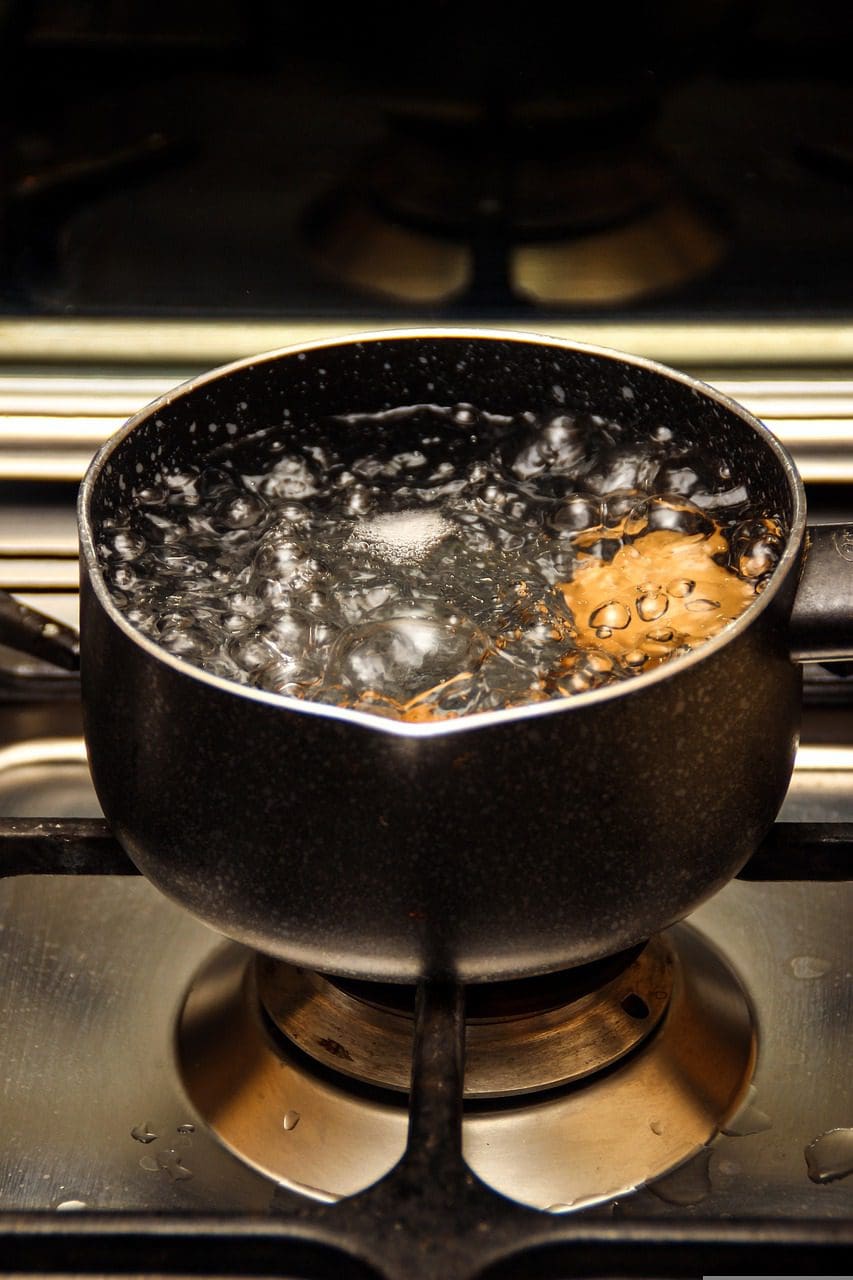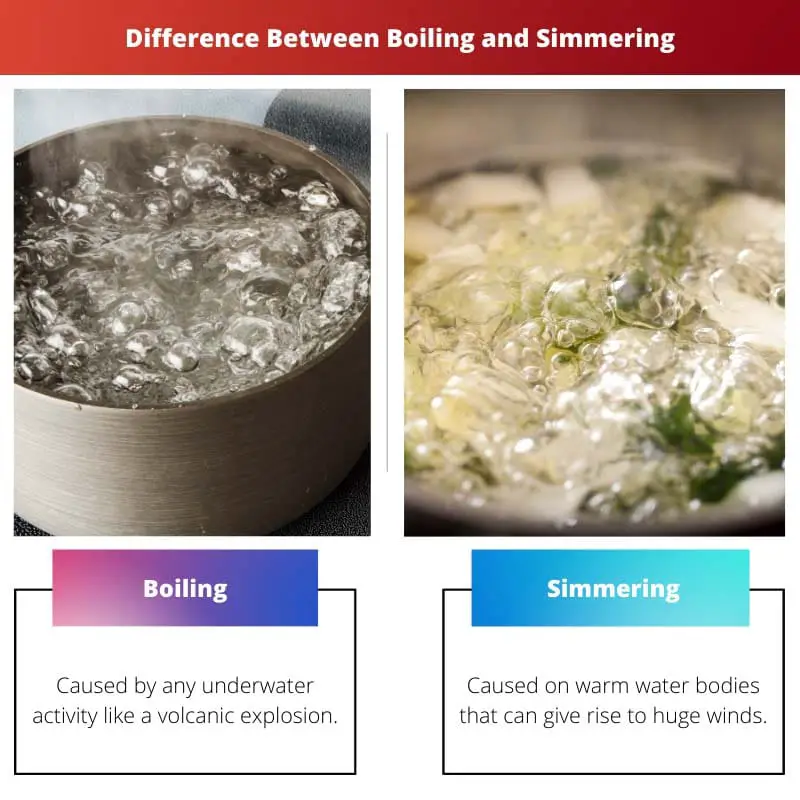The heating of a liquid depends on the rise of temperature that takes place. As the temperature increases, the heating rate also increases. Boiling and Simmering are two such terms that seem alike while they are not.
There are certain differences between both the terms, which make their application different at required times.
Key Takeaways
- Boiling occurs when a liquid reaches its boiling point and bubbles rapidly while simmering occurs when a liquid is heated to a temperature just below its boiling point and bubbles slowly.
- Boiling is used for cooking foods such as pasta or boiling vegetables while simmering is used for soups, stews, and sauces to allow the flavors to meld and develop.
- Boiling is a high-energy cooking method used to sterilize water, while simmering is a low-energy cooking method used to tenderize the meat and infuse flavors.
Boiling vs Simmering
Boiling is the process of heating water or other liquid until it reaches its boiling point, which is 100 degrees Celsius (212 degrees Fahrenheit) at sea level. Simmering is a gentler cooking method that involves heating a liquid to a temperature just below boiling point, around 95 degrees Celsius.

Boiling is the process of heating any liquid at a very high temperature. Boiling occurs at 212 degrees. In this method, the rate of heating is comparatively higher and faster, which makes any tough food item edible during cooking.
It is possible due to large bubbles that get formed due to high temperature.
On the other hand, Simmering is a heating process that takes place at a lower temperature than that boiling. Simmering occurs at around 180-190 degrees and is quite gentler than boiling. It has a lower heating rate and results in smaller bubbles being formed at the water’s surface.
Comparison Table
| Parameters of Comparison | Boiling | Simmering |
|---|---|---|
| Definition | Boiling is a process of heating liquid at a high temperature. | Simmering is a process of heating liquid at a lower temperature. |
| Temperature Requirement | It occurs at 212 degrees. | It occurs at around 180-190 degrees. |
| Bubble Formation | It results in the formation of large bubbles at the water surface. | It results in the formation of comparatively smaller bubbles. |
| Texture | It makes the food items easy to chew. | It makes them gummy and sticky. |
| Duration | It takes lesser time. | It consumes more time. |
| Usage | The food items that have a tough texture are boiled. | The softer food items are shimmered. |
What is Boiling?
Boiled water or food is oh-so-hot when it comes to its temperature. Boiling is a vigorous heating process that is achieved at a very high temperature, i.e., 212 degrees. This temperature is equal to the boiling point of water at sea level.
In order to acknowledge whether something has boiled, one is supposed to notice the surface closely. When there is large bubbles form at the water’s surface and rise vigorously and continuously, that is when it is boiled.
The high temperature causes the bubbles to form at a fast rate. The bubbles rise in the form of steam.
Generally, boiling is of two types- Simple boil and Rolling boil. A simple boil is when large bubbles are formed at the surface of the liquid and rise continuously. In contrast, erupting bubbles are formed in the case of a rolling boil.
There is no change observed in the rate of bubbles even when stirring occurs. This is why it is advised not to touch the surface of the container with bare hands while boiling occurs.
There is a specific reason why food items that have a tough texture are boiled and not shimmered.
It is because boiling makes them edible and easy to chew. Pasta, carrots, broccoli, potato, etc., are included in it. In most cases, boiling is less time-consuming than simmering, but the timing depends on the fire source.

What is Simmering?
Simmering is a job that requires heavy attention. It is a form of the heating process that is achieved at a lower temperature as compared to boiling. The temperature required for simmering is around 180-190 degrees.
If not looked after, a simmer can easily convert into a boil because the temperature gap is much lower. This is why simmering something requires close attention, unlike boiling.
When there are small bubbles form at the water’s surface and tend to rise not as vigorously as boiling, one can be sure that simmering has occurred.
Based on bubble formation, simmer can be of three types– Fine, Simple, and Vigorous. Fine simmer takes place when the bubbles formed are tiny and have a rate close to just a few per two or three seconds.
A simple simmer has slightly larger bubbles than a fine one, and they are continuous. Vigorous simmer has continuous bubble formation, and they rise from the surface as steam.
Simmering is a slower and more time-consuming method than boiling. Food items that are softer and more delicate are shimmered rather than being boiled. It includes poached egg or fish, soft parts of chicken, beef, etc.
For the simmering to be proper, the fire source needs to be adjusted again and again just so that the temperature does not go much higher.

Main Differences Between Boiling and Simmering
- Boiling is defined as heating at a high temperature while simmering is heating at a lower temperature.
- Boiling occurs at 212 degrees while simmering occurs at 180-190 degrees.
- In boiling, larger bubbles are formed and rise from the water surface vigorously, but the bubbles are smaller in simmering.
- Boiling provides an easy-to-chew texture to food, whereas simmering makes the food gummy.
- Simmering is slower and more time-consuming as compared to boiling.
- Tough food items are boiled to make them edible, while delicate and softer food items are shimmered.

- https://www.researchgate.net/profile/Samuel_Ayo/publication/228485667_Design_construction_and_testing_of_an_improved_wood_stove/links/02bfe51373233d718c000000/Design-construction-and-testing-of-an-improved-wood-stove.pdf
- https://www.researchgate.net/profile/Sanusi_Mada/publication/269223635_Effect_of_Boiling_Simmering_and_Blanching_on_the_Antinutritional_Content_of_Moringa_oleifera_Leaves/links/54bfc6850cf28a63249fdf64.pdf

This article clarifies the temperature requirements, bubble formation, and food texture outcomes of boiling and simmering, enhancing knowledge in culinary sciences and food preparation.
The article provides clear temperature and heating rate differences between boiling and simmering, making it a very valuable reference for cooking and chemistry.
The article explains the differences between boiling and simmering with clear and concise descriptions. It is highly beneficial for anyone interested in culinary arts and food science.
The article provides in-depth details on both boiling and simmering processes, which is highly beneficial for enhancing cooking skills and understanding the scientific explanations behind the changes in food textures.
The article clearly explains the differences between boiling and simmering, as well as the applications of both processes. It is quite informative.
The detailed explanations of both boiling and simmering processes in the article are clear and informative, suitable for both beginners and experienced cooks.
The article effectively highlights the importance and outcomes of boiling and simmering. The temperature and bubble formation differences are well explained.
The detailed comparison table in the article makes it easier to understand the differences and uses of boiling and simmering. Very educational.
The article offers comprehensive details and examples regarding boiling and simmering, making it a valuable resource for understanding the key differences and uses of each method.
This article provides a comprehensive understanding of the physical and chemical processes involved in boiling and simmering. Well researched and highly informative.
The article has greatly clarified the distinctions and the uses of both boiling and simmering, providing a valuable learning resource.
I agree, the article presents the differences in a very clear and understandable way. It is indeed a great source of knowledge.